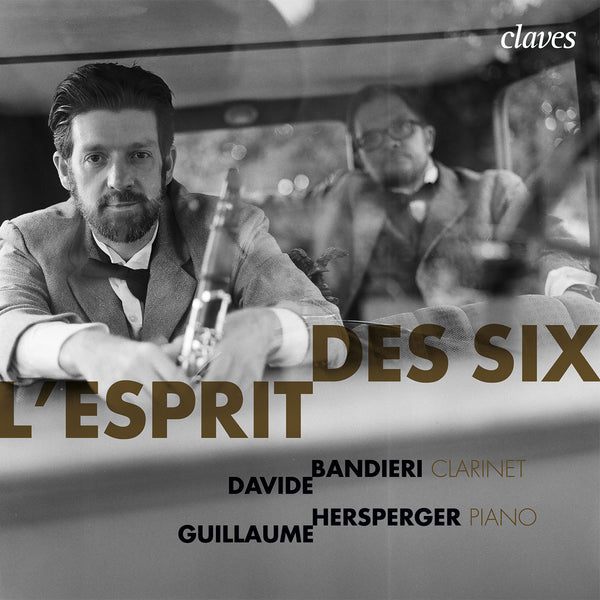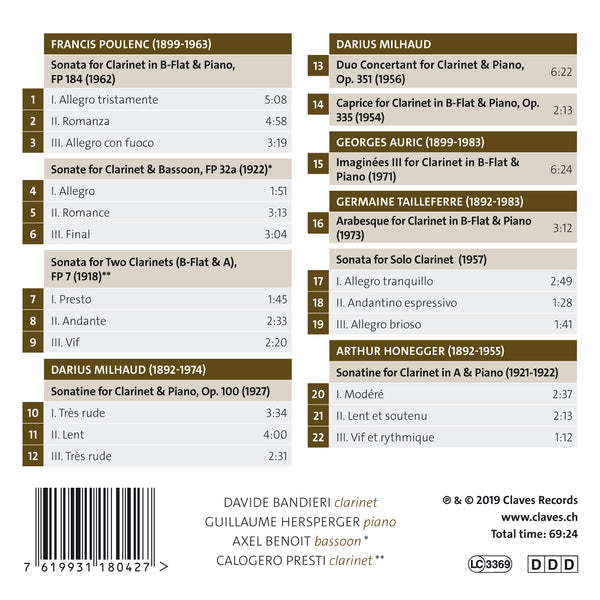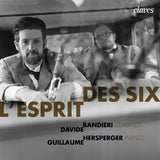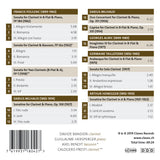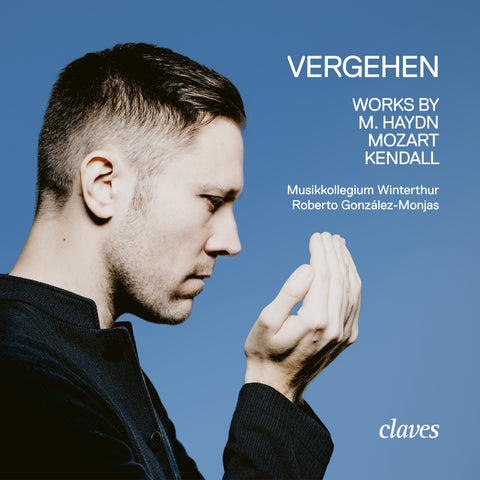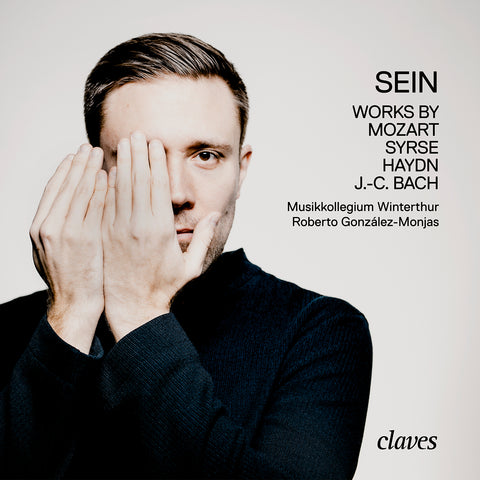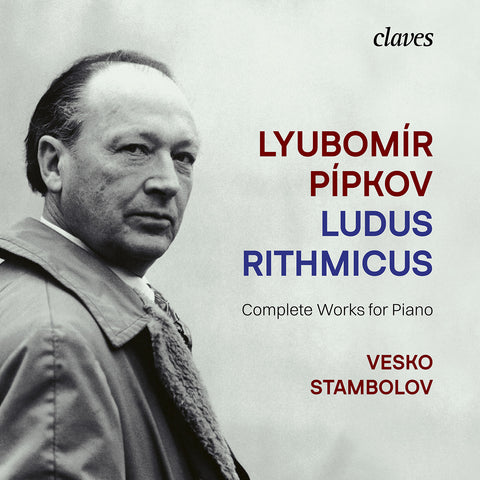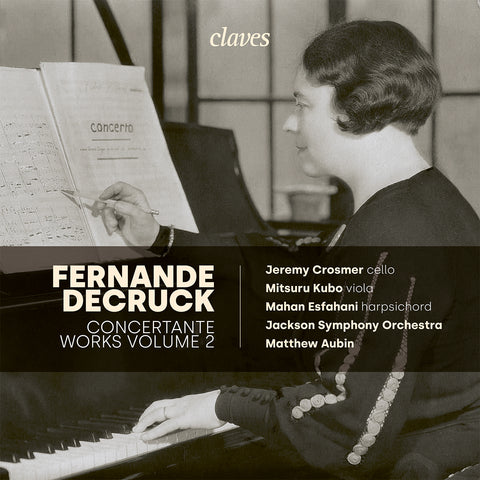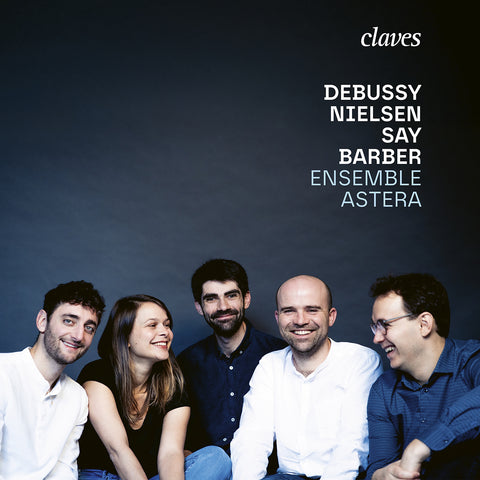(2019) L'Esprit des Six - Davide Bandieri Clarinet, Guillaume Hersperger, piano
Category(ies): Chamber Piano Repertoire
Instrument(s): Bassoon Clarinet Piano
Main Composer: Francis Poulenc
CD set: 1
Catalog N°:
CD 1804
Release: 07.06.2019
EAN/UPC: 7619931180427
This album is now on repressing. Pre-order it at a special price now.
CHF 18.50
This album is no longer available on CD.
This album has not been released yet. Pre-order it from now.
CHF 18.50
This album is no longer available on CD.
CHF 18.50
VAT included for Switzerland & UE
Free shipping
This album is no longer available on CD.
VAT included for Switzerland & UE
Free shipping
This album is now on repressing. Pre-order it at a special price now.
CHF 18.50
This album is no longer available on CD.
This album has not been released yet.
Pre-order it at a special price now.
CHF 18.50
This album is no longer available on CD.
CHF 18.50
This album is no longer available on CD.
L'ESPRIT DES SIX - DAVIDE BANDIERI CLARINET, GUILLAUME HERSPERGER, PIANO
«Les Six», composed of Darius Milhaud (1892-1974), Arthur Honegger (1892-1955), Germaine Tailleferre (1892-1983), Georges Auric (1899-1983), Louis Durey (1888-1979) and Francis Poulenc (1899-1963), was active in Paris during the 1920s. Jean Cocteau (1889-1963) was their poet and spokesperson, and the group considered Erik Satie (1866-1925) to be its spiritual master. Meetings assembling various artistic circles in the salons of Paris at the time permitted the birth of collaborations between creators, reading poems, presenting the latest musical compositions or exhibiting paintings. It was in this context and through the frequentation of the salons that the six musicians, then about twenty years old, became gradually acquainted with each other.
In 1917, an initial performance was given in which poetic, pictorial and especially musical works of four of the six composers were combined with those of Satie. This was the starting point of the small group whose members would regularly present their artistic productions in the same concert halls. They participated in the booming culture of Paris, mainly because spectators of all social classes rushed to attend their performances. In 1919, the name of «Les Six» was created: Henri Collet, a journalist, proposed to give them this name for promotional purposes by analogy with the Group of Five (assembling Russian musicians of the nineteenth century [Mussorgsky, Borodin, Balakirev, Cui, Rimsky-Korsakov]). The magazine Le Coq appeared between April and November 1920 under the aegis of the pen of Cocteau and became the organ of dissemination of the fame of the group even if the latter clarified its position: “The Coq is the organ of no school ... Nothing is less cliquish ... The door is wide open ...”.
Although all came from different backgrounds and kept their individual style of writing, the members of «Les Six» united in opposition to Impressionism and Wagnerism. A form of music-hall filled with popular simplicity characterizes their musical aesthetics. From 1921, however, Cocteau’s design (“Auric, Milhaud, Poulenc, Tailleferre, Honegger, I put your bouquet in the water of the same glass”) was confronted with a certain notoriety which led to the loss of their unity ( “Cocteau tried to put us in the same vase, but we did not hold it”); in spite of their brief existence, alongside their compositions with truculent titles (such as Caramel mou, Salad or Danse de la Chèvre) can be placed emblematic works such as the Album des Six, Le boeuf sur le toit or Les mariés de la tour Eiffel.
***
The spirit of «Les Six» has a special dimension. Camaraderie, humour, a mutual esteem bordering on the most sincere friendship are their main sources of inspiration. As a result, out of their music full of joy of life comes a grasp of existence that is both sweet and funny. It is in this sense that the words of Francis Poulenc describing his friends shed light on the spirit of «Les Six»:
On Georges Auric: “We are exactly the same age – I am only three weeks older - but intellectually, I have always felt his younger brother. The precocity of Georges Auric is such, in all areas, that at the age of fourteen, he was played at the National Society of Music, at sixteen, he discussed sociology with Léon Bloy, theology with Jacques Maritain, and at seventeen, Apollinaire read to him the “Mamelles de Tiresias” asking him for his opinion.”
On Arthur Honegger: “The first few times, Honegger intimidated me, in spite of his good, jolly smile that he always kept, but I was not long in getting to know him and everything was going well when I saw him in “Le Jeu de Robin et Marion” mounted by Bathori at the Vieux Colombier, disguised as a drummer.”
On Germaine Tailleferre: “How lovely she was, our Germaine, in 1917, with her schoolbag full of all the first prizes of the Conservatoire! She was so kind and talented - she always is! - extraordinarily talented! But I sometimes regret that she has not extracted from herself all what a Marie Laurencin, for example, has learned from her feminine genius.”
On Louis Durey: “The loyal Durey who, by some scruple, separated from us at the moment when “Les mariés de la tour Eiffel Tower”, consecrated, in a way also quite ephemeral, our arbitrary group. Louis Durey, the silent Durey, was the image of modesty and nobility. I dedicated to him my first melodies, “Le Bestiaire”, which I had composed without knowing it at the same time as his own. I would like to see in this appreciative tribute the tenderness in which I have always held him.”
On Darius Milhaud: “When Milhaud returned from Brazil, it was a sudden infatuation, as valuable in friendship as in love. He was so attractive, this robust Mediterranean, leaning on a thin cane of rhinoceros, dressed in light grey, with strawberry and lemon ties. He was so amusing with his stories of the Tropics and it was really delicious to hear him play with that adorably careless touch of his “Albums de voyage, Saudades do Brasil” or “Le boeuf sur le toit.”
The dizzying atmosphere that prevailed at the Saturday nights of «Les Six» is also portrayed by Darius Milhaud, thereby revealing the aesthetic movement underlying the musical production of the “samedistes”:
“The formation of «Les Six» contributed to strengthen our friendship. During two years, we regularly met at my place, every Saturday night. Paul Morand was making cocktails, then we went to a small restaurant up on “Rue Blanche”. The hall of the “Petit Bessonneau” was so small that the “samedistes” occupied it entirely. They indulged themselves without restraint to their exuberance. There were not only composers among us but also performers: Marcelle Meyer, Juliette Meerovitch, Andrée Vaurabourg, the Russian singer Koubitzky; painters: Marie Laurencin, Irène Lagut, Valentine Gross, the fiancee of Jean Hugo, Guy Pierre Fauconnet; writers: Lucien Daudet, Radiguet, a young poet whom Cocteau brought us. After dinner, attracted by the steam rides, the mysterious shops, the “Fille de Mars”, the shooting, the lotteries, the menageries, the din of the mechanical organs with perforated rollers that seemed to grind implacably and simultaneously all the “flonflons” of music-hall and “revues”, we went to the Fair of Montmartre, and sometimes to the Circus Medrano to attend the sketches of the Fratellini which denoted so much imagination and poetry that they were worthy of the Commedia dell’Arte. We ended the evening at my place. Poets read their poems. We played our last works. Some of them, like Auric’s “Adieu New York”, Poulenc’s “Cocardes”, and my “Boeuf sur le toit” were continually rehashing. We even asked Poulenc to play “Cocardes” every Saturday, which he did with the best goodwill in the world. From those meetings where happiness and carelessness seemed to be the only climate, many fruitful collaborations were born; moreover, they determined the character of certain works that flowed from the aesthetics of the music hall.
Even though the clarinet and piano pieces - with the exception of Honegger’s Sonatine - were written after the band stopped assembling, this carefree period seems to impregnate them with the prism of a form of nostalgia for these encounters.
***
Beyond the burlesque, even nostalgic, the music of «Les Six» interpenetrates the most advanced poetic research of the time. The collaborations between poets and musicians were numerous as evidenced by the privileged links which united Paul Claudel (1868-1955) to Honegger, Milhaud and Tailleferre, Guillaume Apollinaire (1880-1918) to Honegger and Tailleferre as well as Cocteau to the whole group.
The result of these exchanges is an aspiration to modernity and a certain simplicity of which Satie had already opened the way: “Satie invents a new simplicity. The transparent air undresses the lines. The pain does not wince.”
The schema which consists in finding the essence of a music which reflects its time in a exigence of truth is expressed for example in Milhaud through a highlighting of the fundamental element of the air, considered in both its musical and organic sense: “The most difficult thing in music is always to write a melody that can be self-sufficient. This is the secret of music. But the essential is the vital element, the air that can be remembered, humming, hissing in the street. The melody, the only living element, alone allows a work to last.”
Which echoes Claudel in his conception of the links between music and poetry:
“Milhaud and I ...we wanted to show how the soul comes gradually to the music, how the sentence springs from the rhythm, the flame of fire, the melody of the word, the poetry of the grossest reality, and how all the means of sound expression, from discourse, dialogue and debate supported by simple drums, to the eruption of all the vocal, lyrical and orchestral riches, come together in a single torrent at once diverse and uninterrupted. We wanted to show the music not only in the state of realization, of grimoires distributed on the pages of the score, but in the nascent state when it springs out and overflows with a violent and deep feeling.”
It is thus in this founding ignorance, in this acceptance of a happy technical deprivation, in this sharing of human fraternity reflected in the musical means implemented by the composers of «Les Six», that perhaps lies the beauty of their production. The effort of their lyricism preserves in its popular vein the fragile quality of the silence present in speech, on the model of Claudel: “I am initiated into silence” to which René Char (1907-1988) will later add: “silence is the case of truth”.
Associated with the great mysteries of existence that the poem is intended to approach, their music stands on a ridge halfway between the ascetic silence, which deprives itself of a certain scholarly idea of writing, and the direct expression of a deliciously simple world. Cocteau in this sense affirms the depth of this paradox:
“We must not take simplicity for the synonym of poverty or for a decline. Simplicity progresses just as the refinement and the simplicity of our modern musicians is no longer that of harpsichordists. The simplicity that comes in response to a refinement is part of this refinement; it releases, it condenses the acquired wealth.”
This is perhaps where «Les Six» draws its spiritual value, literally and figuratively...
“We belong to no one but to the golden point of this lamp unknown to us, inaccessible to us, which awakens courage and silence.”
Antoine Gilliéron
Translated from French by Caroline Mercier and William Eisler
***
Videos from their official Facebook's page: L'Esprit des Six
(2019) L'Esprit des Six - Davide Bandieri Clarinet, Guillaume Hersperger, piano - CD 1804
«Les Six», composed of Darius Milhaud (1892-1974), Arthur Honegger (1892-1955), Germaine Tailleferre (1892-1983), Georges Auric (1899-1983), Louis Durey (1888-1979) and Francis Poulenc (1899-1963), was active in Paris during the 1920s. Jean Cocteau (1889-1963) was their poet and spokesperson, and the group considered Erik Satie (1866-1925) to be its spiritual master. Meetings assembling various artistic circles in the salons of Paris at the time permitted the birth of collaborations between creators, reading poems, presenting the latest musical compositions or exhibiting paintings. It was in this context and through the frequentation of the salons that the six musicians, then about twenty years old, became gradually acquainted with each other.
In 1917, an initial performance was given in which poetic, pictorial and especially musical works of four of the six composers were combined with those of Satie. This was the starting point of the small group whose members would regularly present their artistic productions in the same concert halls. They participated in the booming culture of Paris, mainly because spectators of all social classes rushed to attend their performances. In 1919, the name of «Les Six» was created: Henri Collet, a journalist, proposed to give them this name for promotional purposes by analogy with the Group of Five (assembling Russian musicians of the nineteenth century [Mussorgsky, Borodin, Balakirev, Cui, Rimsky-Korsakov]). The magazine Le Coq appeared between April and November 1920 under the aegis of the pen of Cocteau and became the organ of dissemination of the fame of the group even if the latter clarified its position: “The Coq is the organ of no school ... Nothing is less cliquish ... The door is wide open ...”.
Although all came from different backgrounds and kept their individual style of writing, the members of «Les Six» united in opposition to Impressionism and Wagnerism. A form of music-hall filled with popular simplicity characterizes their musical aesthetics. From 1921, however, Cocteau’s design (“Auric, Milhaud, Poulenc, Tailleferre, Honegger, I put your bouquet in the water of the same glass”) was confronted with a certain notoriety which led to the loss of their unity ( “Cocteau tried to put us in the same vase, but we did not hold it”); in spite of their brief existence, alongside their compositions with truculent titles (such as Caramel mou, Salad or Danse de la Chèvre) can be placed emblematic works such as the Album des Six, Le boeuf sur le toit or Les mariés de la tour Eiffel.
***
The spirit of «Les Six» has a special dimension. Camaraderie, humour, a mutual esteem bordering on the most sincere friendship are their main sources of inspiration. As a result, out of their music full of joy of life comes a grasp of existence that is both sweet and funny. It is in this sense that the words of Francis Poulenc describing his friends shed light on the spirit of «Les Six»:
On Georges Auric: “We are exactly the same age – I am only three weeks older - but intellectually, I have always felt his younger brother. The precocity of Georges Auric is such, in all areas, that at the age of fourteen, he was played at the National Society of Music, at sixteen, he discussed sociology with Léon Bloy, theology with Jacques Maritain, and at seventeen, Apollinaire read to him the “Mamelles de Tiresias” asking him for his opinion.”
On Arthur Honegger: “The first few times, Honegger intimidated me, in spite of his good, jolly smile that he always kept, but I was not long in getting to know him and everything was going well when I saw him in “Le Jeu de Robin et Marion” mounted by Bathori at the Vieux Colombier, disguised as a drummer.”
On Germaine Tailleferre: “How lovely she was, our Germaine, in 1917, with her schoolbag full of all the first prizes of the Conservatoire! She was so kind and talented - she always is! - extraordinarily talented! But I sometimes regret that she has not extracted from herself all what a Marie Laurencin, for example, has learned from her feminine genius.”
On Louis Durey: “The loyal Durey who, by some scruple, separated from us at the moment when “Les mariés de la tour Eiffel Tower”, consecrated, in a way also quite ephemeral, our arbitrary group. Louis Durey, the silent Durey, was the image of modesty and nobility. I dedicated to him my first melodies, “Le Bestiaire”, which I had composed without knowing it at the same time as his own. I would like to see in this appreciative tribute the tenderness in which I have always held him.”
On Darius Milhaud: “When Milhaud returned from Brazil, it was a sudden infatuation, as valuable in friendship as in love. He was so attractive, this robust Mediterranean, leaning on a thin cane of rhinoceros, dressed in light grey, with strawberry and lemon ties. He was so amusing with his stories of the Tropics and it was really delicious to hear him play with that adorably careless touch of his “Albums de voyage, Saudades do Brasil” or “Le boeuf sur le toit.”
The dizzying atmosphere that prevailed at the Saturday nights of «Les Six» is also portrayed by Darius Milhaud, thereby revealing the aesthetic movement underlying the musical production of the “samedistes”:
“The formation of «Les Six» contributed to strengthen our friendship. During two years, we regularly met at my place, every Saturday night. Paul Morand was making cocktails, then we went to a small restaurant up on “Rue Blanche”. The hall of the “Petit Bessonneau” was so small that the “samedistes” occupied it entirely. They indulged themselves without restraint to their exuberance. There were not only composers among us but also performers: Marcelle Meyer, Juliette Meerovitch, Andrée Vaurabourg, the Russian singer Koubitzky; painters: Marie Laurencin, Irène Lagut, Valentine Gross, the fiancee of Jean Hugo, Guy Pierre Fauconnet; writers: Lucien Daudet, Radiguet, a young poet whom Cocteau brought us. After dinner, attracted by the steam rides, the mysterious shops, the “Fille de Mars”, the shooting, the lotteries, the menageries, the din of the mechanical organs with perforated rollers that seemed to grind implacably and simultaneously all the “flonflons” of music-hall and “revues”, we went to the Fair of Montmartre, and sometimes to the Circus Medrano to attend the sketches of the Fratellini which denoted so much imagination and poetry that they were worthy of the Commedia dell’Arte. We ended the evening at my place. Poets read their poems. We played our last works. Some of them, like Auric’s “Adieu New York”, Poulenc’s “Cocardes”, and my “Boeuf sur le toit” were continually rehashing. We even asked Poulenc to play “Cocardes” every Saturday, which he did with the best goodwill in the world. From those meetings where happiness and carelessness seemed to be the only climate, many fruitful collaborations were born; moreover, they determined the character of certain works that flowed from the aesthetics of the music hall.
Even though the clarinet and piano pieces - with the exception of Honegger’s Sonatine - were written after the band stopped assembling, this carefree period seems to impregnate them with the prism of a form of nostalgia for these encounters.
***
Beyond the burlesque, even nostalgic, the music of «Les Six» interpenetrates the most advanced poetic research of the time. The collaborations between poets and musicians were numerous as evidenced by the privileged links which united Paul Claudel (1868-1955) to Honegger, Milhaud and Tailleferre, Guillaume Apollinaire (1880-1918) to Honegger and Tailleferre as well as Cocteau to the whole group.
The result of these exchanges is an aspiration to modernity and a certain simplicity of which Satie had already opened the way: “Satie invents a new simplicity. The transparent air undresses the lines. The pain does not wince.”
The schema which consists in finding the essence of a music which reflects its time in a exigence of truth is expressed for example in Milhaud through a highlighting of the fundamental element of the air, considered in both its musical and organic sense: “The most difficult thing in music is always to write a melody that can be self-sufficient. This is the secret of music. But the essential is the vital element, the air that can be remembered, humming, hissing in the street. The melody, the only living element, alone allows a work to last.”
Which echoes Claudel in his conception of the links between music and poetry:
“Milhaud and I ...we wanted to show how the soul comes gradually to the music, how the sentence springs from the rhythm, the flame of fire, the melody of the word, the poetry of the grossest reality, and how all the means of sound expression, from discourse, dialogue and debate supported by simple drums, to the eruption of all the vocal, lyrical and orchestral riches, come together in a single torrent at once diverse and uninterrupted. We wanted to show the music not only in the state of realization, of grimoires distributed on the pages of the score, but in the nascent state when it springs out and overflows with a violent and deep feeling.”
It is thus in this founding ignorance, in this acceptance of a happy technical deprivation, in this sharing of human fraternity reflected in the musical means implemented by the composers of «Les Six», that perhaps lies the beauty of their production. The effort of their lyricism preserves in its popular vein the fragile quality of the silence present in speech, on the model of Claudel: “I am initiated into silence” to which René Char (1907-1988) will later add: “silence is the case of truth”.
Associated with the great mysteries of existence that the poem is intended to approach, their music stands on a ridge halfway between the ascetic silence, which deprives itself of a certain scholarly idea of writing, and the direct expression of a deliciously simple world. Cocteau in this sense affirms the depth of this paradox:
“We must not take simplicity for the synonym of poverty or for a decline. Simplicity progresses just as the refinement and the simplicity of our modern musicians is no longer that of harpsichordists. The simplicity that comes in response to a refinement is part of this refinement; it releases, it condenses the acquired wealth.”
This is perhaps where «Les Six» draws its spiritual value, literally and figuratively...
“We belong to no one but to the golden point of this lamp unknown to us, inaccessible to us, which awakens courage and silence.”
Antoine Gilliéron
Translated from French by Caroline Mercier and William Eisler
***
Videos from their official Facebook's page: L'Esprit des Six
Return to the album | Read the booklet | Composer(s): Francis Poulenc | Main Artist: Davide Bandieri







